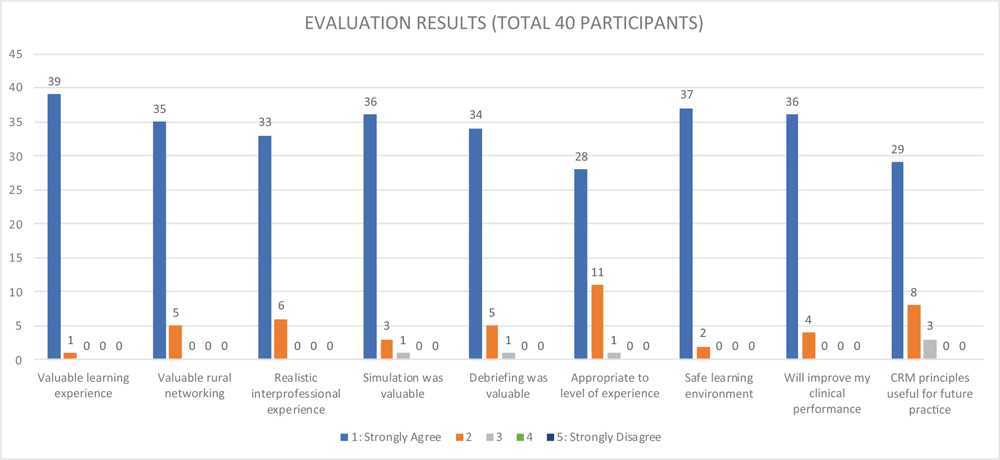Development of a Rural Inter-professional Simulation Course: an initiative to improve trauma and emergency team management in New Zealand rural hospitals
Marc Gutenstein 1 2 , Sampsa Kiuru 1 2 , Steve Withington 1 2
1 2 , Sampsa Kiuru 1 2 , Steve Withington 1 2
1 Rural Health Academic Centre, University of Otago, Canterbury, New Zealand
2 Rural Postgraduate Programme, University of Otago, Dunedin, New Zealand
3 Correspondence to: Marc Gutenstein, Rural Health Academic Centre, University of Otago, Canterbury 8140, New Zealand. Email: marc.gutenstein@otago.ac.nz
Journal of Primary Health Care 11(1) 16-23 https://doi.org/10.1071/HC18071
Published: 15 February 2019
Journal Compilation © Royal New Zealand College of General Practitioners 2019.
This is an open access article licensed under a Creative Commons Attribution-NonCommercial-NoDerivatives 4.0 International License.
Abstract
BACKGROUND AND CONTEXT: New Zealand is a largely rural nation. Despite the regionalisation of trauma services, rural hospitals continue to provide trauma and emergency care. A dedicated rural inter-professional team-based simulation course was designed, as part of a wider strategy of using simulation-based education to address the disparity in experience and training for rural hospital teams providing emergency and trauma care.
ASSESSMENT: A pre-course questionnaire identified learning needs. Post-course evaluation and a follow-up survey assessed participants’ perception of the course, and whether lasting changes in clinical or organisational practice occurred.
RESULTS: Three courses were provided over 2 years to 60 interprofessional participants from eight rural hospitals. The course employed an interprofessional faculty and used skill workshops and high-fidelity trauma simulations to address learning needs identified in pre-course research. Evaluation showed the course to be an effective learning experience for participants. The post-course survey indicated possible lasting changes in team performance and rural hospital protocols. This educational strategy also allowed the collection of research data for investigating rural team dynamics and interprofessional learning.
STRATEGIES FOR IMPROVEMENT: Further development of rural interprofessional simulation courses should include more diverse clinical content, including paediatric and medical scenarios. Participant access was sometimes limited by typical rural challenges such as hospital staffing and locum availability.
LESSONS: Rural simulation-based education is both effective for rural trauma team training and a vehicle for rural research; however, there are challenges to participant access and course sustainability, which echo the rural–urban disparity.
| WHAT GAP THIS FILLS |
| What is already known: Disparities exist in rural trauma and emergency care, and the networks and educational resources available to support rura teams. Simulation-based education is an evidence-based intervention. |
| What this study adds: A rural interprofessional simulation course successfully used simulation-based education to train real rural teams in technical and non-technical trauma skills. The course also provided a valuable networking opportunity, was a useful platform for faculty development, and a vehicle for ongoing rural research. |
Introduction
Rural trauma and emergency care in New Zealand
New Zealand is a largely rural nation with a geographically dispersed population. Existing research suggests that the trauma burden in rural areas is at least as high, if not higher, than urban areas. Despite this, access to health services in rural areas is more limited. For example, rates of moderate-to-severe traumatic brain injury in rural New Zealand may be higher than urban rates,1 local access to computed tomography (CT) imaging is likely to be lower,2 or even absent,3 and trauma centres in New Zealand are without exception urban.
Clinical team training and performance may also differ between rural and urban areas. Much of the work that specialist teams manage in urban areas is managed by generalist teams in rural New Zealand. Rural teams must handle high-risk scenarios such as trauma and emergencies as part of their scope of practice; however, these situations are relatively infrequent. As trauma and emergency care is increasingly centralised to urban hospitals through coordinated networks of care,4 team performance may be further hampered by lack of clinical exposure and experience, as high-risk scenarios become lower in frequency but not entirely absent from rural clinical practice.5
Access to education and research often mirrors access to health-care facilities, being centralised into urban teaching hospitals. Currently, there is no rural school of health in New Zealand. Although most urban New Zealand teaching hospitals now have dedicated training units and simulation suites, to date there is no coordinated approach to rural trauma team training. Therefore, rural–urban disparities in trauma and emergency care may be exacerbated by lack of exposure to difficult cases, poorer access to collegial networks of specialist support, and fewer opportunities for rural-specific education and training.6 The aim of this project was to develop an educational intervention to address these perceived disparities.
Simulation-based education as a rurally targeted intervention
Simulation-based education is an evidence-based education method used widely in medical and nursing training, and used in several countries to train rural trauma teams.7–9 There is evidence supporting simulation training for procedural skill instruction10 and interprofessional team performance.11,12 Compared with non-simulation-based instruction, simulation increases learner satisfaction and team skills in resuscitation.13 There is sufficient evidence to suggest that better non-technical skills lead to better team function and better processes of care.14 Simulation training improves various patient safety outcomes in different contexts,15 but research specific to rural team training is limited. Rural team training in the United States (USA) has been shown to reduce time to transfer,16 but there is less evidence to support patient-oriented outcomes.
In New Zealand, simulation training has been used for several years as part of the Rural Postgraduate Programme for vocational training in the speciality of Rural Hospital Medicine.17 Although national projects such as NetworkZ18 support surgical team training, a gap exists for simulation-based education specifically targeted to the rural hospital workforce. Rural interventions must specifically address the needs of rural patients, hospitals and clinical teams, rather than simply scaling urban interventions. Simulation-based education is expected to be particularly useful for rural hospital team training as it deals particularly with disparities previously described6 and potentially has benefits beyond the direct effects of training, such as procedural skills maintenance, standardisation of equipment and procedures, and enhanced teamwork, to also enhance the ability to highlight latent threats in team performance, encourage a culture of safe interprofessional learning and promote rural-specific research.
Simulation theory
The conceptual framework underpinning simulation-based education frequently draws upon the theories of Bloom19 and Kolb20 to understand the objectives and experience of learning, respectively. According to the revised Taxonomy of learning by Bloom19 (Fig. 1), remembering and understanding are the simplest levels of learning. The ability of learners to apply or analyse knowledge is a better indicator of competence. Simulation-based education can help learners move from knowledge of an area of expertise, to its application in real clinical environments. The learning cycle described by Kolb20 is currently the main conceptual framework used for experiential learning (Fig. 2). It describes a cycle of concrete experience, reflection, conceptualisation and experimentation. Simulation-based education can thus be understood as a process of experiencing a simulation scenario, debriefing (when reflective learning occurs) and implementing new behaviours during a subsequent simulation experience. Due to the need to create challenging experiences and intellectual discomfort as part of reflective learning, effective simulation-based education requires a heavy emphasis on creating psychological safety through the use of a safe container for learning and a robust debriefing technique.21 Existing team hierarchies and behaviours may be deeply embedded through many years of practice, and challenging previously held assumptions requires a deep level of trust in both faculty and co-participants.
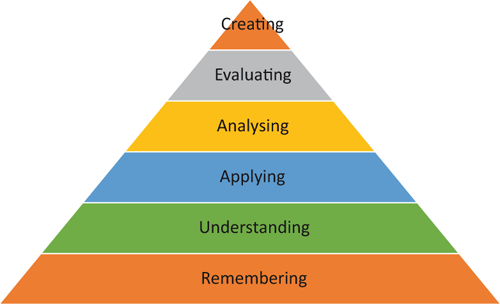
|
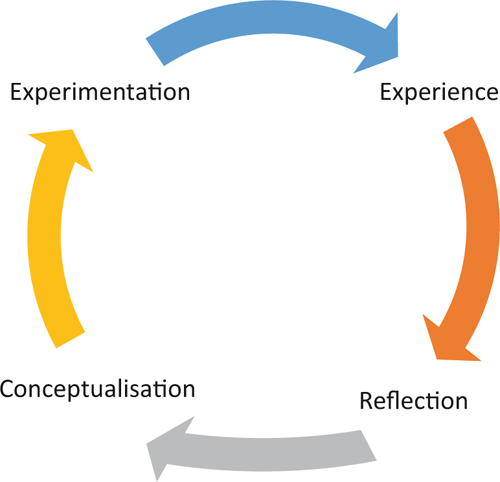
|
The Rural Inter-professional Simulation Course
This paper describes the first 2 years of the Rural Inter-professional Simulation Course (RiSC) project, an interprofessional course specifically designed for rural hospital teams. The clinical aim was to deliver a targeted interprofessional course, to improve clinician trauma skills and enhance rural hospital teamwork. Educational goals were to develop faculty skills and experience in simulation and debriefing, and to build a wider curriculum for rural hospital service improvement. Research goals were to use the project to foster research into rural teamwork and rural interprofessional educational practice.
Course development
Course design
A 3-day immersion course was delivered with procedural skills training, simulation scenarios, lectures and didactic content. Didactic content was minimal according to the pedagogical principle of the ‘flipped classroom’, whereby knowledge acquisition is left to participants to achieve pre-course and the emphasis is on the application of knowledge to practice. For this reason, it was recommended that all participants had previously attended an advanced trauma course. Skills sessions were included, which represented the major psychomotor skills that emergency and trauma teams need for both their clinical practice and their maintenance of professional standards. These included airway procedures, chest trauma skills, vascular access skills and fracture splinting methods. High-fidelity simulation scenarios were designed around a similar skill set in order to layer the learning from the conceptual to psychomotor skills, to including the same skills within coordinated team practice. ‘Native’ interprofessional teams (team members who normally work together in their place of practice) were invited to attend the course from around New Zealand. For each course, four teams of five participants, containing two to three doctors and two to three nurses per team, travelled to Ashburton Hospital, Canterbury, where the course was delivered.
The RiSC course was designed to harness and strengthen existing knowledge commonly conveyed by existing courses such as Early Management of Severe Trauma (EMST)22 or the Trauma Nursing Core Course (TNCC)23 and translate this into the application of psychomotor skills and the non-technical communication, teamwork and leadership skills commonly understood as Crisis Resource Management.24 A pre-course survey was used to inform simulation scenario design. Scenarios were written for rural authenticity; for example, limits were placed around accessibility of advanced imaging, blood products and backup. Teams were encouraged to enter the scenario in a staged fashion, reflecting the first and second on-call arrangements of a typical rural hospital, and handover to retrieval teams was facilitated. The professional needs of participants were met by ensuring the course fulfilled the revalidation needs of professional colleges such as the Division of Rural Hospital Medicine and the Australian College of Rural and Remote Medicine.
Facility
The location for the course was the simulation suite at the Rural Health Academic Centre in Ashburton. Simulation-based education can take place in situ in a real clinical workplace or away from the live clinical environment in a simulation laboratory. While in situ training is thought to be generally more effective and evidence supports a positive effect on patient safety outcomes,25 it can be limited by competing for space and resources with live clinical activity and also necessarily can only apply to one institution. Conversely, laboratory-based simulation can be delivered to many different teams at the same time and without the pressure of real patients competing for resources. This has the added advantage of teams being able to network with and learn from colleagues around the country. Facility and training equipment relied heavily on multi-agency collaboration, with the University of Otago, Canterbury District Health Board and St John Ambulance contributing to the project.
Faculty development
A standardised approach was adopted for simulation and debriefing based on the Simulation Instructor Course provided by the Centre for Medical Simulation in Boston, USA.26 Collaboration with other South Island organisations had identified this as a globally accepted educational standard for simulation faculty that would enable a consistent ethos and style of simulation and debriefing across the South Island, and enable an interprofessional faculty. By developing a collaborative and interprofessional educator team, we could add authenticity, create a robust faculty and boost educator confidence.27
Research development
From inception, the course was envisaged as a vehicle for educational research, alongside the core learning objectives. A framework was developed for progressively researching different levels of course impact, from individual and team skills and performance, to system and policy change at participants’ local hospital sites, and patient outcomes. Initially, an in-depth evaluation of participant perceptions of the course effectiveness and its effect on clinical practice was performed. Subsequently, tools were identified and developed to more formally assess changes in interprofessional team performance (taskwork) and process (teamwork).28 A confidentiality policy and research agreement was developed to cater for these different levels of research.
Ethical aspects
Ethical considerations were given to performing research within an educational course. In particular, video recording required a security policy and password-protected and controlled access to recordings. A confidentiality recording and research policy was written and circulated to participants ahead of the course for their informed consent as research participants. During the course, a heavy emphasis was placed on creating a ‘safe container’ for learning.
Assessment
A pre-course qualitative educational needs assessment was collected from participants using a survey contained in the application form. Immediate post-course qualitative and quantitative evaluation was performed online using the University of Otago’s OtagoInform platform.29 A questionnaire for capturing participant experience and evaluation of the course was developed using a five-point Likert-type rating scale, with responses ranging from 1 = Strongly Agree to 5 = Strongly Disagree. Specific qualitative feedback was also sought from participants regarding multiple aspects of the course. To assess ongoing changes, follow-up email and phone communication with participants collected qualitative feedback at both personal and service level at 3 months after the course.
Results of assessment
Analysis of the pre-course survey indicated the commonest themes and detailed learning requirements (Table 1). While many of these could be catered for by the course design, which was centred around adult trauma emergencies, several important clinical scenarios were omitted, including paediatric content. A feature of these learning objectives was that they were often based around the real-life challenges that the teams had previously faced in their rural hospital.
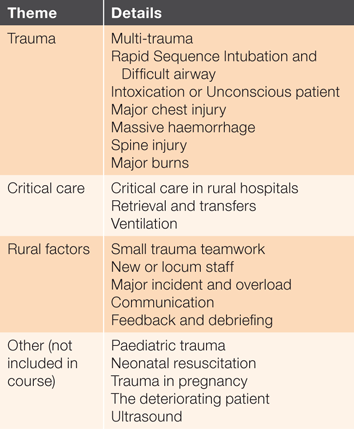
|
In 2017 and 2018, three RiSC courses were delivered to a total of 60 participants, with 27 doctors and 33 nurses taking part, from eight rural hospitals around the North and South Islands of New Zealand. Course evaluation was received from 40 of 60 participants (response rate 67%). Responses were positive overall (Fig. 3). Qualitative feedback identified areas for improvement, including technical issues such as audio-visual quality, and course delivery issues such as themes for future scenario-based learning.
Results from the post-course survey at 3 months (Table 2) suggested that the RiSC course remained useful to participants, their teams and their organisations. Four hospitals sent more than one team to attend the course.
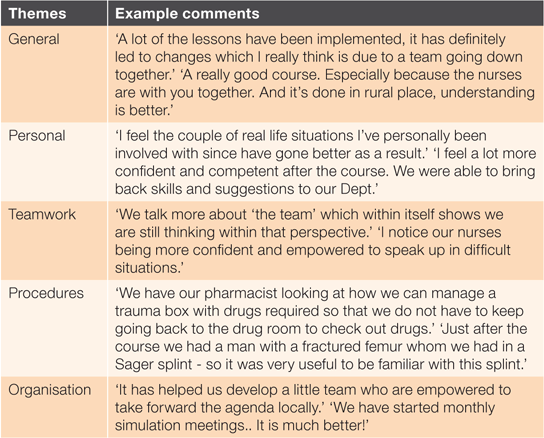
|
Strategies for quality improvement
As clinical practice in pre-hospital and emergency care is rapidly evolving, future iterations of the course will require regular revision of content to reflect the contemporary practice environment. Our research indicates an appetite for simulation-based education in other clinical domains. Future courses will contain a selection of new simulation scenarios that reflect these learning needs, although the scope of the course is limited to adult trauma.
Opportunities exist to apply this model of course delivery and faculty development to other clinical contexts. These include developing other learning objectives for acute medicine and paediatrics, and other locations including in situ in rural hospitals using mobile simulation and audio-visual equipment. By increasing the network of involved rural teams, opportunities also exist to use RiSC courses to develop standardised rural emergency practices, while team-based research will allow development of recommended rural approaches to Crisis Resource Management and emergency care.
Lessons and messages
The Rural Inter-professional Simulation Course was developed to address a perceived disparity in trauma and emergency care in rural New Zealand. Using rurally focused simulation-based education, we hoped to close the gap between urban and rural trauma and emergency team performance. Three courses over 2 years trained 60 interprofessional participants from eight rural hospitals. Evaluation indicated that the learning objectives matched learning requirements, and participants found the learning experience to be realistic and valuable, including simulation and debriefing, Crisis Resource Management content and networking with rural colleagues. Participants believed that the course would improve their clinical practice, and after 3 months, lasting changes were evident. These positive findings are comparable to results from other countries, where courses specifically designed for rural health care practitioners (rather than scaled or adapted from urban courses) have demonstrably increased participants’ confidence and perceived competence to work in rural or remote practices.9 The course was also a useful platform for faculty development in simulation-based education and a vehicle for ongoing research into rural teams and interprofessional education.
The project faces sustainability challenges, including a high faculty–student ratio and a resource-intensive learning context, as is typical of simulation-based education. Both faculty and equipment provision depended on multi-agency collaboration, which added to the value, but also the complexity and cost of course implementation. The course was also limited by the same factors it was designed to mitigate – those of rural disparity. Expressions of interest outnumbered teams able to attend, often for logistical reasons, and one course was cancelled when subscribed teams could not access roster cover in order to take educational leave. Although benefiting from rural authenticity, the rural simulation suite was less well developed than equivalent urban university settings. Although faculty development and exploration of effective low-cost audio-visual solutions was part of initial course development, further work is needed. Rural limitations of staffing and equipment are commonplace, and simulation-based education relies heavily on audio-visual technology for an effective learning experience. Further research will be useful to determine the durability of practice changes, and whether changes in patient-related outcomes can be detected.
Funding
The work was initiated by the University of Otago Rural Postgraduate Programme and developed as a collaboration with the Rural Health Academic Centre Ashburton, St John, and Canterbury District Health Board. A University of Otago Committee for Advancement of Learning with Technology grant was used to develop a recording policy and associated assessment tools for debriefing.
Conflicts of interest
None.
Acknowledgements
The authors wish to acknowledge the University of Otago Christchurch Simulation Centre, Canterbury District Health Board, St John Ambulance, Canterbury Simulation Interest Group, and South Island Alliance
References
[1] Feigin VL, Theadom A, Barker-Collo S, et al. Incidence of traumatic brain injury in New Zealand: a population-based study. Lancet Neurol. 2013; 12 53–64.| Incidence of traumatic brain injury in New Zealand: a population-based study.Crossref | GoogleScholarGoogle Scholar | 23177532PubMed |
[2] Nixon G, Samaranayaka A, de Graaf B, et al. Geographic disparities in the utilisation of computed tomography scanning services in southern New Zealand. Health Policy. 2014; 118 222–8.
| Geographic disparities in the utilisation of computed tomography scanning services in southern New Zealand.Crossref | GoogleScholarGoogle Scholar | 24973925PubMed |
[3] Keys J, Venter L, Nixon G. The use of CT in the management of minor head injuries in Queenstown. J Prim Health Care. 2017; 9 162–6.
| The use of CT in the management of minor head injuries in Queenstown.Crossref | GoogleScholarGoogle Scholar | 29530228PubMed |
[4] New Zealand Out-of-Hospital Major Trauma Triage Policy. 2017. [cited 2018 September 1]. Available from: http://docs.wixstatic.com/ugd/bbebfb_12ccb22c9dc648ee8ab5fd095ebc9ba6.pdf
[5] Hansen G, Beer DL, Vallance JK. The impact of transport of critically ill pediatric patients on rural emergency departments in Manitoba. Can J Rural Med. 2017; 22 8–12.
| 28234603PubMed |
[6] Gutenstein M, Kiuru S. The Matthew effect in New Zealand rural hospital trauma and emergency care : why rural simulation-based education matters. N Z Med J. 2018; 131 7587
[7] Rural Trauma Team Development Course. [cited 2018 September 1]. Available from: https://www.facs.org/quality-programs/trauma/education/rttdc
[8] Ker J, Cachia P, Beasant B. A national approach for the use of simulation to educate and train the NHS workforce: the First National Clinical Skills Strategy. Scott Med J. 2015; 60 220–2.
| A national approach for the use of simulation to educate and train the NHS workforce: the First National Clinical Skills Strategy.Crossref | GoogleScholarGoogle Scholar | 26403570PubMed |
[9] Willett TG, Kirlew M, Cardinal P, Karas P. An evaluation of the Acute Critical Events Simulation (ACES) course for family medicine residents. Can J Rural Med. 2011; 16 89–95.
| 21718625PubMed |
[10] Huang GC, McSparron JI, Balk EM, et al. Procedural instruction in invasive bedside procedures: a systematic review and meta-analysis of effective teaching approaches. BMJ Qual Saf. 2016; 25 281–94.
| Procedural instruction in invasive bedside procedures: a systematic review and meta-analysis of effective teaching approaches.Crossref | GoogleScholarGoogle Scholar | 26543067PubMed |
[11] Fung L, Boet S, Bould MD, et al. Impact of crisis resource management simulation-based training for interprofessional and interdisciplinary teams: a systematic review. J Interprof Care. 2015; 29 433–44.
| Impact of crisis resource management simulation-based training for interprofessional and interdisciplinary teams: a systematic review.Crossref | GoogleScholarGoogle Scholar | 25973615PubMed |
[12] Brown LL, Overly FL. Simulation-based interprofessional team training. Clin Pediatr Emerg Med. 2016; 17 179–84.
| Simulation-based interprofessional team training.Crossref | GoogleScholarGoogle Scholar |
[13] Mundell WC, Kennedy CC, Szostek JH, Cook DA. Simulation technology for resuscitation training: a systematic review and meta-analysis. Resuscitation. 2013; 84 1174–83.
| Simulation technology for resuscitation training: a systematic review and meta-analysis.Crossref | GoogleScholarGoogle Scholar | 23624247PubMed |
[14] Civil I. Are non-technical skills relevant for the delivery of high quality trauma care? Injury. 2016; 47 1875–6.
| Are non-technical skills relevant for the delivery of high quality trauma care?Crossref | GoogleScholarGoogle Scholar | 27566008PubMed |
[15] Patterson MD, Geis GL, LeMaster T, Wears RL. Impact of multidisciplinary simulation-based training on patient safety in a paediatric emergency department. BMJ Qual Saf. 2013; 22 383–93.
| Impact of multidisciplinary simulation-based training on patient safety in a paediatric emergency department.Crossref | GoogleScholarGoogle Scholar | 23258388PubMed |
[16] Dennis BM, Vella MA, Gunter OL, et al. Rural trauma team development course decreases time to transfer for trauma patients. J Trauma Acute Care Surg. 2016; 81 632–37.
| Rural trauma team development course decreases time to transfer for trauma patients.Crossref | GoogleScholarGoogle Scholar | 27438684PubMed |
[17] Blattner K, Nixon G, Gutenstein M, Davey E. A targeted rural postgraduate education programme linking rural doctors across New Zealand and into the Pacific. Educ Prim Care. 2017; 28 346–50.
| A targeted rural postgraduate education programme linking rural doctors across New Zealand and into the Pacific.Crossref | GoogleScholarGoogle Scholar | 28468576PubMed |
[18] Network Z. Better outcomes in acute care. [cited 2018 September 1]. Available from: www.networkz.ac.nz.
[19] Zigmont JJ, Kappus LJ, Sudikoff SN. Theoretical foundations of learning through simulation. Semin Perinatol. 2011; 35 47–51.
| Theoretical foundations of learning through simulation.Crossref | GoogleScholarGoogle Scholar | 21440810PubMed |
[20] Stocker M, Burmester M, Allen M. Optimisation of simulated team training through the application of learning theories: a debate for a conceptual framework. BMC Med Educ. 2014; 14 69
| Optimisation of simulated team training through the application of learning theories: a debate for a conceptual framework.Crossref | GoogleScholarGoogle Scholar | 24694243PubMed |
[21] Rudolph JW, Raemer DB, Simon R. Establishing a safe container for learning in simulation. Simul Healthc J Soc Simul Healthc. 2014; 9 339–49.
| Establishing a safe container for learning in simulation.Crossref | GoogleScholarGoogle Scholar |
[22] Early Management of Severe Trauma. [cited 2018 September 1]. Available from: https://www.surgeons.org/for-health-professionals/register-courses-events/skills-training-courses/emst/
[23] Trauma Nursing Core Course. [cited 2018 September 1]. Available from: https://www.ena.org/education/tncc
[24] St. Pierre M, Hofinger G, Simon R. Crisis Management in Acute Care Settings. 3rd edn. Springer International Publishing; 2016.
[25] Fent G, Blythe J, Farooq O, Purva M. In situ simulation as a tool for patient safety: a systematic review identifying how it is used and its effectiveness. BMJ Simul Technol Enhanc Learn. 2015; 1 103–10.
| In situ simulation as a tool for patient safety: a systematic review identifying how it is used and its effectiveness.Crossref | GoogleScholarGoogle Scholar |
[26] Centre for Medical Simulation. [cited 2018 September 1]. Available from: https://harvardmedsim.org/
[27] Darlow B, McKinlay E, Gallagher P, et al. Building and expanding interprofessional teaching teams. J Prim Health Care. 2017; 9 29–33.
| Building and expanding interprofessional teaching teams.Crossref | GoogleScholarGoogle Scholar | 29530185PubMed |
[28] Grand JA, Pearce M, Rench TA, et al. Going DEEP: guidelines for building simulation-based team assessments. BMJ Qual Saf 2013; 22 436–48.
| Going DEEP: guidelines for building simulation-based team assessments.Crossref | GoogleScholarGoogle Scholar | 23355693PubMed |
[29] Otago in Form. Quality Advancement Unit. Te Huka Whai ki te Matariki. Otago in Form Questionnaires. [cited 2018 September 1]. Available from: https://inform.otago.ac.nz/


